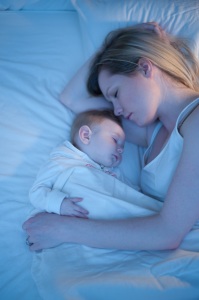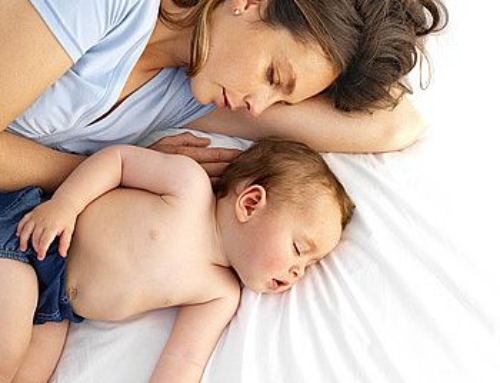Texas is on pace for a record number of “bedsharing” deaths this year: The record is 174 (in 2011) and this year so far they are already at 172. Officials have launched a $100,000 campaign to curb these deaths by – you guessed it – telling parents how dangerous it is to bedshare ever. A spokesperson for the state’s Child Protective Services said, “A lot of people don’t realize just how many babies lose their lives every year with co-sleeping or bed-sharing as a factor. That’s not saying that it necessarily caused those deaths, but we know that it was factor in each one.”
Let me get this straight: Officials can acknowledge that bedsharing may not have “caused” the deaths, but they assume the worst anyway. Let’s ignore for a moment the hypocrisy that no one blames cribs simply because a child was in one at the time of death. I want to focus on the “advice”, a term that can only be used loosely here because it consists of one thing and one thing only: Don’t bedshare.
For years public health agencies have been attempting to curb infant deaths by focusing on the devil that is bedsharing. They have one message and one message only: Bedsharing is always dangerous and should never be done. They ignore the research that delves deep into risk factors and doesn’t support this
IT’S NOT WORKING!
Over the years of campaigns telling parents not to bedshare, we have seen one thing happen: More families are bedsharing than ever before. They aren’t doing it to spite healthcare workers, policy makers, or their doctors and they certainly care deeply about the well-being of their babies and their families. They do it because it helps them. It helps them get more sleep, it helps breastfeeding (especially supply), and it often helps their baby too by allowing baby to get more sleep, cry less, and learn to self-regulate (via physiological synchrony)[6].
You can rant as much as you like about the “dangers” of bedsharing, about the increased deaths and you still won’t change things because evolutionarily speaking, this type of proximity is incredibly natural for mother-infant dyads to seek. The question you need to be asking yourself is this: How can we help people understand the risks?
The same spokesperson mentioned above said, “My baby is six months old, and I know how difficult it is when you’re extremely tired and you just want to do anything to get them to go to sleep, but what we’ve seen in these cases is that it really the safest for them to have their own space and have plenty of room to breathe.” Without realizing it, she’s highlighted the very issue at play: Sleep-deprived parents doing anything, which sadly includes unsafe bedsharing.
I ask you to imagine a mother who has been told over and over again not to bedshare, so she doesn’t. She has a baby that is higher-needs and wakes regularly for feedings and comfort; her baby is one of those who is unable to regulate himself physiologically well-enough on his own and requires mom’s help. Night after night, she wakes to feed four or five times (quite normal), sitting in a rocking chair, fighting off sleep until she can put him down, head back to bed, and try and get another stretch before it starts again. Finally, after the two months of this and the third waking, she can’t take it anymore and takes her baby back to bed with her for the rest of the night. She doesn’t check to make sure her bed is safe for her young child, she can’t think of anything else but getting more sleep.
Most times, this very scenario will play out just fine. Despite SIDS and suffocation being the leading cause of death for infants, they are still incredibly rare. However, there are times it will go bad and according to one study, this unplanned nature of bringing a baby to bed described above is exactly what is risky. Parents who plan to bedshare presumably take the precautions to make sure it’s a safe environment and this is likely why there is no increased risk of SIDS for this group[7]. Sleep research is showing us that it’s not so much the lowered amount of sleep that causes severe mental disruptions, but the lack of completing sleep cycles[8], something that is very difficult when your infant naturally has a shorter sleep cycle[9] than you and may wake every one to two cycles for a period of months (yes, that’s normal). Thus it shouldn’t be surprising that constant sleep disruption in the form of having to get up and feed a baby before returning to sleep leads to faulty decision-making.
Imagine if instead of the constant warnings of bedsharing, officials instead offered information. If they spoke about why some families bedshare (cultural reasons, ease of breastfeeding, more sleep, etc.) and how to make it safe if a family wants to do it, but also offered other alternatives if their home isn’t a safe environment or they don’t want to. Talk about using co-sleepers to ease the disruption. Talk about how sleep deprivation can lead us to bring our babies into bed when it’s least safe and that we need to make provisions ahead of time, before we increase the risk exponentially because we’re at a loss for what else to do. What might the numbers of bedsharing deaths look like then? Would we see a consistent increase or might we see the change that has eluded officials for years now?
In short, isn’t it time we treat parents like human beings capable of making decisions that are best for their families and instead of hide information from them, give them the tools they need to make the safest decisions for their babies and their families? Is that really asking so much?
——————
[1]Blabey MH, Gessner BD. Infant bed-sharing practices and associated risk factors among births and infant deaths in Alaska. Public Health Reports 2009; 124: 527-34. [2]Blair PS, Fleming PJ, Smith IJ et al. Babies sleeping with parents:case control study of factors influencing the risk of the sudden infant death syndrome. CESDI SUDI research group. British Medical Journal 1999;319: 1457–1462. [3]McKenna JJ, Thoman EB, Anders TF, Sadeh A, Schechtman VE, & Glotzbach GT. Infant-parent co-sleeping in an evolutionary perspective: Implications for understanding infant sleep development and the sudden infant death syndrome. Sleep (1993); 16: 263-282. [4]Carpenter RG, McGarvey C, Mitchell EA, Tappin DM, Vennemann MM, et al. Bed sharing when parents do not smoke: is there a risk of SIDS? An individual level analysis of five major case-control studies. BMJ Open 2013; 3: e002299. [5]Trifunov W. The practice of bed sharing: A systematic literature and policy review. Prepared for the Public Health Agency of Canada (2009). [6]Feldman R. From biological rhythms to social rhythms: physiological precursors of mother-infant synchrony. Developmental Psychology 2006; 42: 175-88. [7]Vennemann MM, Bajanowski T, Brinkmann B, Jorch G, Sauerland C, Mitchell EA. Sleep environment risk factors for Sudden Infant Death Syndrome: the German Sudden Infant Death Syndrome study. Pediatrics 2009; 123: 1162-70. [8]McBean AL, Montgomery-Downs HB. Diurnal fatigue patterns, sleep timing, and mental health outcomes among healthy postpartum women. Biological Research for Nursing 2014; doi:10.1177/1099800414528278. [9] Stern E, Parmelee AH, Akiyama Y, Schultz MA, Wenner WH. Sleep cycle characteristics in infants. Pediatrics 1969; 43: 65-70.






[…] Plan for “Record-Setting Bedsharing Deaths”? Same Old Thing (And It Doesn’t Work) …. […]
Hear hear! Beautifully put!
I knew before giving birth to my daughter that my patents bed-shared with me and my brother when we were babies. They told me how to do it.
But seeing as how I now live in a western country, it had been drilled so much that bed sharing is dangerous I decided to go half way and get a co-sleeper. My awesome high-needs baby decided she would only sleep on me or my partner for the first 3 weeks and afterwards (untill at about 10 months!) only at the boob.
3 days/nights of staying awake on the couch watching series to fight off sleep and I almost drifted to sleep with baby on me…thats when I realized how stupid and dangerous it is and took my baby safely (I woke my partner and asked him to double check and watch us for a while as my head was very fuzzy). It was the most natural thing in the world. Beautiful. Even tired I was 100% aware of her and every breath she took. Like when there’s music on in an elevator but you’ve heard is so often and so much it drifts to the background…and when it stops for a second you know it stopped. Which her breath did twice. And so I nudged her and she started breathing again. Im glad I was there. Yes there are monitors but I have the feeling mommy is a way better monitor, because a mommy helps regulate baby’s breath too. Point being bedsharing in safe conditions is not only great but done safely it can prevent nasty things from happening.
We started bed sharing for the same reason. We had a cosleeper, but after a few scary times waking sitting up in bed with my daughter on the My Breast Friend, I started side nursing. I kept falling asleep that way and finally convinced my husband that it was as best if we just planned for this to happen. She is 2 now and still joins us in bed every night. Bonus: we never ended up buying the crib.